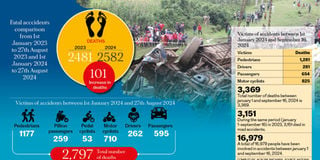
A graphic showing the fatal accidents comparison from January 2023 and August 2024
Imagine a Jumbo aircraft crashing and killing all passengers and crew on board. Worse, think of such a horrific air tragedy happening every single month since January this year.
It may sound outrageous, but that is the magnitude of road carnage in Kenya since 2024 began, with more than 3,369 people having perished in accidents in the first nine months.
Ordinarily, a Jumbo, with a typical three-class arrangement, can accommodate between 301 to 368 passengers, including about a dozen crew members.
God forbid, if such crashes were to happen in Kenya every 30 days, the grieving chaos, the human and economic losses, the time-consuming investigations by global aviation authorities, and the attendant court cases would be of unimaginable scale and proportion.
For instance, nearly six years after Ethiopian Airlines’ Flight ET302 killed all 157 passengers in March 2019, Ethiopian officials are still trading accusations with Boeing Corporation over mechanical faults they say downed the 737-MAX 8 aircraft.
However, the real picture of Kenya road fatalities could be worse given that the NTSA statistics only capture incidents that were reported to police.
According to data from the National Police Service, whose Traffic department is mandated to enforce compliance with road safety rules, 3,369 Kenyans had perished through road accidents as of September 16, translating to 374 people per month, and at least 12 persons every 24 hours.
Of the total deaths, 1,281 were pedestrians, followed by 825 motorcyclists, 654 passengers, and 281 drivers.
The data also reveals that a total of 16,979 people were affected by road accidents, mainly by sustaining life-threatening injuries.
The figures mark a slight increase in road fatalities compared to the same period last year when 3,151 people died in traffic accidents.
In real terms, the grim numbers of deaths on our roads are equivalent to one 14-seater matatu crashing every day, with no single survivor.
Compared to other African states, the figures also put Kenya among the countries unable to rein in reckless driving, which has been cited as one of the main causes of accidents.
According to the latest report by World Health Organization (WHO), Africa has the highest road death rate, with an average of 19.45 deaths per every 100, 000 people annually, and Kenya is ranked among the worst six countries in road safety.
In the 2024 WHO status report on road fatalities, Kenya comes sixth in Africa, with a mortality rate of 28.2 per every 100,000 road users, after Guinea (37.4), Libya (34.0), Guinea-Bissau (30.5), Zimbabwe (29.9) and Comoros (29.1).
Within the East Africa Community, Kenya still has the worst score on road safety, despite Nairobi having a better road infrastructure compared to its neighbours.
In order to address the devastating toll of road accidents, the government, through the National Transport and Safety Authority (NTSA), is implementing the five-year National Road Safety Action Plan 2024 -2028, which was launched by President William Ruto in April this year.
Despite the multi-sectoral efforts to reverse the alarming rate of road accidents, which not only shatters families and devastates communities but also poses a significant economic burden on the nation, the death toll remains high.
Some of the worst accidents that have shocked the country like the six school children killed on the spot by a speeding hit-and-run vehicle in Kitui County and the Londiani crash that left 53 people dead in Kericho County could have been avoided.
Beyond the Road Safety Action Plan spearheaded by NTSA, the carnage statistics have jolted the Kenya National Highways Authority (KeNHA) to propose radical measures to inculcate a culture of road safety among Kenyans through a curriculum module in schools.
KeNHA, the road agency in charge of national trunk roads, has embarked on a road safety sensitisation campaign targeting schools in several regions with the aim of entrenching a new safe driving and road use culture.
According to KeNHA Regional Director for Lower Eastern Engineer James Kariuki, across the world, the best practice in dealing with road accidents has been the adoption of three Es— Education, Engineering, and Enforcement.
Mr Kariuki said road accidents were killing more people than diseases like cancer or malaria, and only education would help reverse the trend.
"As we scale up safety engineering measures in road construction and enforcement of traffic rules, creating road safety awareness through education is less costly and most effective in changing people's behaviours," he said.
He spoke in Ikutha along Kibwezi-Kitui Road when he led a delegation of KeNHA engineers and NTSA officials to inspect the section where an accident claimed six school pupils last month.
He led KeNHA and NTSA officials in distributing road safety educational materials to primary schools located along the Kibwezi - Kitui highway.
The materials contained basic information for children under the age of 10.
"The data showing 1,281 pedestrians killed on the roads means every child must be taught about road safety. Similarly, the hawkers encroaching their merchandise on road pavements must be told… that their safety is at great risk," he said.
The KeNHA official said the tragedy of losing 374 people every month is a major crisis that needs a serious rethink of policies, and suggested mandatory mainstreaming of road safety lessons right from Grade One in the new competency-based curriculum in schools.
He said the Education Ministry, through the Kenya Institute of Curriculum Development, should take the lead in developing learning materials for all cadres, where every primary school has road safety clubs in every class with safety champions as team leaders.
"Enforcement of traffic rules and crackdown on errant drivers will not fully change the bad driving culture but inculcating road safety through education, especially from lowest grades will in the long run eliminate accidents because every person is a road user," he said.
Kitui Woman Representative Irene Kasalu welcomed the proposals, saying no effort should be spared to reverse the road carnage trend.
Dr Kasalu said it was estimated that road carnage costs Kenya's economy a staggering Sh450 billion annually and she would champion the necessary legislation to deal with the menace.
These losses, she noted, arise from the cost of treatment as well as lost productivity for those killed or disabled by their injuries, and for family members who must take time off work or school to care for the injured.
NTSA Director General George Njau said the agency is developing a National Road Safety Policy, which aims to strengthen the existing multi-sectoral coordination and mainstream road safety in all public sectors.
Mr Njau said the policy would establish a multi-sectoral County Transport and Safety Committees (CTSCs) to coordinate enforcement and monitor road safety trends.
"We plan to improve the road safety data collection and analysis system to enhance its functionality and accessibility, where errant drivers can have their licenses revoked," says the NTSA boss.





